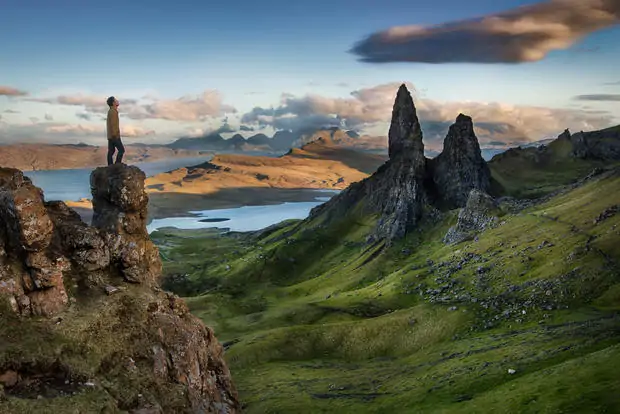Earth Day is the celebration of the environmental protection movement and an annual reminder to appreciate and care for our planet. In reality, we often feel the need to make a conscious effort to distance ourselves from our daily lives and distractions to focus on the world around us. The beauty of wildlife, the power of the elements and the majesty of nature all somehow seem easier to appreciate when we unplug ourselves from the noise and toys of the modern world.
So, in the spirit of taking a breath and savouring our planet, we offer our take on the best places to unplug and get back to nature.
Torres del Paine National Park, Patagonia, Chile
At the southern tip of South America where the Andes meets the sea, the Patagonia region, part Argentina and part Chile, is a world removed from most everyone’s everyday life. With growing glaciers that periodically toss ice chunks into lakes, towering mountain tops and wild, windswept terrain, Patagonia is a testament to the powerful forces of nature. There are six national parks in Patagonia, including Torres del Paine. Though fire swept through much of the park in 2011, the three granite peaks that give the park its name were not damaged. These monolithic peaks, which reach more than 9,000 feet, are joined by waterfalls, glaciers and lakes, all fed by the Southern Patagonia Ice Field. The park is also home to a dozen or more species of birds of prey as well as guanacos, pumas, foxes as more. Out here, in these wilds, the best electronic device to pack is a great camera.
Kennebec River, Maine, United States
In the depths of Maine, four hours northwest of Portland, a 12-mile stretch of the upper gorge of the Kennebec River offers a wet, wild and definitely remote adventure. A handful of outfitters offer rafting outings on the Kennebec and nearby Dead and Penobscot Rivers are filled with class two through five rapids. Part adrenaline rush, part splash park, a day or two on the river is a sure fire way to immerse yourself in the moment and truly embrace your surroundings. After all, with high rock walls that cut out most data feeds, a phone-drowning flood of water and the occasional up ended boat that scatters everything and everyone aboard, there is not much point in trying to communicate with anyone or anything else.
Great Ocean Ecolodge, Cape Otway, Australia
Located in the middle of the huge Cape Otway Conservation Area, the Great Ocean Ecolodge is surrounded by nothing but pure wilderness and the company of kangaroos, koalas and the beautiful nature of South Australia, about four hours from Melbourne. During the day, visitors work with the team of researchers affiliated with the Cape Otway Center for Conservation Ecology out in the forest, helping with the various conservation and wildlife protection projects. In the evening, there’s an excellent meal served in the company of vacationers from around the world and a good book by the fireplace.
Salkantay Trek to Machu Picchu, Peru
The Salkantay Trek may be the long way to the Lost City of the Incas, but it will get you off the beaten path, literally. An alternative to the increasingly popular and crowded Inca Trail, this trek can vary from a five- to seven-day journey and takes you more than 15,000 feet in elevation before dropping down to the cloud forest and then back up to Machu Picchu itself. Make your way through the Salkantay Pass in the shadow of its 20,000 foot summit, pass through the 15 ecosystems, with everything from hanging glaciers to orchids and butterflies, or catch your first glimpse of the ancient mountain-top ruins — just don’t expect to “check-in” unless you have a satellite phone.
The lakes of northwestern Ontario, Canada
Why go fly fishing when you can go “fly-in” fishing? Much of upper Ontario is peppered with lakes of all sizes (and not much else). The more remote the lake, the more fish there are. So, for a chance to match wits with a 20-inch walleye or fight the good fight with a 30-pound pike, your best bet may be to board a small float plane and wing off to the wilderness for a week. Outfitters offer cabins and lodges in secluded spots (often the only house on a lake) throughout Ontario, flight included. Many promise you will see plenty of fish, game, great sunrises and peace and quiet but that you won’t hear a car engine the whole time you’re there.
Koh Tonsay, Cambodia
Here’s your chance to sleep in a bamboo hut on stilts in a tropical paradise. The tiny island of Koh Tonsay, three miles offshore from the tourist town of Kep in the Gulf of Siam, is barely more than a square mile in area but is home to two beautiful beaches and clear waters. It has no cars or motorbikes and electricity for just a few hours in the evening. Don’t book your hut online, either. You can make your sleeping arrangements in person in Kep. Do stay over, though, both for dinner of incredibly fresh (pulled from the water when you order) seafood and a late-night swim in the bioluminescent water.
Tarangire National Park, Tanzania
Imagine trading your cubicle for a luxury tent and your daily commute for a ride on an open air jeep. Picture swapping the crowd on the street for a herd of migrating elephants, and you start to get an idea of what a visit to Tarangire National Park is like. This park in northern Tanzania, while open year round, comes to life in the dry months of summer when the animals come in droves to search for water. Rife with elephants in particular but also home to wildebeest, zebras, giraffes and mongoose as well as a huge (and diverse) bird population, the 1,100-mile park puts on a show that rivals bigger and better known reserves when the animals are on the move. However, because it’s a bit off the traditional safari circuit, Tarangire is a one of the most rustic and remote corners of parkland in Africa.
Bardsey Island, Wales
This small island off the coast of the Lleyn Peninsular of North Wales has a storied history, dating back to the 6th century and perhaps earlier. Ruins remain from a 13th century abbey and stories tell of a much earlier Celtic Christian monastery as well as burial grounds for 20,000 “saints” from the Middle Ages. Access to the 1.5-mile long island is by boat only. While popular as a day trip destination, for a modern dose of the contemplative life, plan to rent one of the nine houses on the island for a week. A stay is a step back in time as all but one of the houses was built in the 1870s and none is equipped with electricity or bathrooms. Cold running water, lanterns, refrigeration and stoves are, however, included. So too is the quiet beauty of the island and its renowned bird and marine life and sea cliff habitat.
Khan Khentii, Mongolia
The steppes of Mongolia remain largely unchanged by time. Nomadic herdsmen have roamed this region for thousands of years and, to keep the lands and traditions protected, the government has established a “Khan Khentii Strictly Protected Area.” To get a taste of this untouched land and ancient lifestyle, plan a yak trek where locals will take you through the region, most often on horseback, while yak-drawn carts bring supplies. Nights are spent in tents, known locally as gers, and days are spent on the move, exploring the extensive wildlife and changing landscape. This region of eastern Mongolia is where Genghis Khan was born and is rumored to be buried. Despite the fearsome warring traditions of the past, the herdsmen today are welcoming to those who cross into their world for a glimpse of their ancient lifestyle.
Green Bank, West Virginia, United States
To find out about nature beyond our planet, sometimes it requires shutting down the electronic noise in our own backyard. In Green Bank, W.V., the use of cell phones, Wi-Fi or anything else that emits a radio frequency is forbidden. The reason? The town is home to the giant Green Bank Telescope, which uses radio signals to explore space. The telescope is surrounded by a 13,000 square mile National Radio Quiet Zone, which covers the eastern half of West Virginia and into a corner of Virginia. The FCC picked this region in the 1950s in part because the Alleghany Mountains served as a natural shield from signals that would interfere with the telescope’s work. So, whether you want a front row view of space exploration or an extremely quiet trip to the mountains (there are two national parks in the radio-free zone), this is your chance. Just bring some change for the pay phone.
Featured image by gogri



